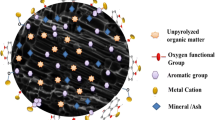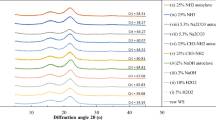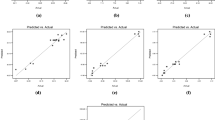Abstract
The efficiency of sodium sulfide-assisted alkaline pulping for cellulose preparation from Oryza sativa L. rice straw in Vietnam for enzymatic saccharification was investigated. The response surface methodology was used for the determination of optimal technological parameters of alkaline pulping such as active alkali dosage, temperature and time. The optimal technological parameters were established to be active alkali dosage of 7%, treatment temperature of 100 °C and treatment time of 120 min. At these regimes, a maximal sugar yield of 51.8% (over dry rice straw) was obtained. It meant that the saccharification efficiency up to 97.1% could be achieved by using sodium sulfide-assisted alkaline pretreatment method. Addition of sodium sulfide into alkaline pretreatment resulted in higher sugar yield, higher level of depolymerization of lignin and less loss of cellulose. Moreover, liquid hydrolyzate after enzymatic hydrolysis was analyzed by HPLC to determine the compositions of sugar mixture. The fiber morphology in pretreated biomass solid was also revealed by SEM.






Similar content being viewed by others
References
Dien LQ, Phuong NTM, Hoa DT, Hoang PH (2015) Efficient pretreatment of vietnamese rice straw by soda and sulfate cooking methods for enzymatic saccharification. Appl Biochem Biotechnol 175:1536–1547. doi:10.1007/s12010-014-1359-3
Eggeman T, Elander RT (2005) Process and economic analysis of pretreatment technologies. Bioresour Technol 96:2019–2025. doi:10.1016/j.biortech.2005.01.017
Ek M, Gellerstedt G, Henriksson G (2009) Pulp & paper chemistry and technology. Walter de Gruyter GmbH&Co, Berlin
Eniko V, Zsolt S, Kati R (2002) Chemical pretreatments of corn stover for enhancing enzymatic digestibility. Appl Biochem Biotechnol 98–100:73–87. doi:10.1385/ABAB:98-100:1-9:73
Faveri DD, Torre P, Perego P, Converti A (2004) Statistical investigation on the effects of starting xylose concentration and oxygen mass flowrate on xylitol production from rice straw hydrolyzate by response surface methodology. J Food Eng 65:383–389. doi:10.1016/j.jfoodeng.2004.01.037
Garrote G, Dominguez H, Parajo JC (2002) Autohydrolysis of corncob: study of non-isothermal operation for xylooligosaccharide production. J Food Eng 52:211–218. doi:10.1016/S0260-8774(01)00108-X
Gaspar M, Kalman G, Reczey K (2007) Corn fiber as a raw material for hemicellulose and ethanol production. Process Biochem 42:1135–1139. doi:10.1016/j.procbio.2007.04.003
Harinder SO, Praveen VV, Khushal B, Vinod KB, Ramabhau TP (2010) Enhanced ethanol production via fermentation of rice straw with hydrolysate-adapted Candida tropicalis ATCC 13803. Process Biochem 45:1299–1306. doi:10.1016/j.procbio.2010.04.017
Hsu TC, Guo GL, Chen WH, Hwang WS (2010) Effect of dilute acid pretreatment of rice straw on structural properties and enzymatic hydrolysis. Bioresource Technol 101:4907–4913. doi:10.1016/j.biortech.2009.10.009
Jaruwan S, Natchanun L, Teerapatr S, Ancharida A (2008) Evaluation of dilute-acid pretreated bagasse, corn cob and rice straw for ethanol fermentation by Saccharomyces cerevisiae. Ann Microbiol 58:219–225. doi:10.1007/BF03175320
Jorgensen H, Kristensen JB, Felby C (2007) Enzymatic conversion of lignocellulose into fermentable sugars: challenges and opportunities. Biofuels Bioprod Biorefin 1:119–134. doi:10.1002/bbb.4
Kim S, Dale BE (2004) Global potential bioethanol production from wasted crops and crop residues. Biomass Bioenergy 26:361–375. doi:10.1016/j.biombioe.2003.08.002
Kim I, Han JI (2012) Optimization of alkaline pretreatment conditions for enhancing glucose yield of rice straw by response surface methodology. Biomass Bioenergy 46:210–217. doi:10.1016/j.biombioe.2012.08.024
Kim SB, Lee SJ, Lee JH, Jung YR, Laxmi PT, Kim JS, Um YS, Park C, Kim SW (2013) Pretreatment of rice straw with combined process using dilute sulfuric acid and aqueous ammonia. Biotechnol Biofuels 6:109–119. doi:10.1186/1754-6834-6-109
Maiorella BI (1983) Ethanol. In: Young M (ed) Industrial chemicals, biochemicals and fuels, V. 3, comprehensive biotechnology. Pergamon Press, pp 861–914
Maroušek J (2013) Study on commercial scale steam explosion of winter Brassica napus straw. Int J Green Energy 10:944–951. doi:10.1080/15435075.2012.732158
Miller GL (1959) Use of dinitrosalicylic acid reagent for determination of reducing sugar. Anal Chem 31:426–428. doi:10.1021/ac60147a030
Noordin MY, Venkatesh VC, Sharif S, Elting S, Abdullah A (2004) Application of response surface methodology in describing the performance of coated carbide tools when turning AISI 1045 steel. J Mater Process Technol 145:46–58. doi:10.1016/S0924-0136(03)00861-6
Parameswaran B, Raveendran S, Reeta RS, Surender V, Lalitha D, Satya N, Noble K, Rajeev KS (2010) Bioethanol production from rice straw: an overview. Bioresour Technol 101:4767–4774. doi:10.1016/j.biortech.2009.10.079
Ramesh S, Muthuvelayudham R, Rajesh KR, Viruthagiri T (2013) Statistical optimization of medium composition and process variables for xylitol production from rice straw hemicellulose hydrolysate by debaryomyces hansenii var hansenii. J Microbiol Biotechnol Food Sci 2:2332–2339
Saha BC (2003) Hemicellulose bioconversion. Ind Microbiol Biotechnol 30:279–291. doi:10.1007/s10295-003-0049-x
Yang LF, Cao J, Jin YC, Chang HM, Jameel H, Phillips R, Li ZZ (2012) Effects of sodium carbonate pretreatment on the chemical compositions and enzymatic saccharification of rice straw. Bioresour Technol 124:283–291. doi:10.1016/j.biortech.2012.08.041
Yu SC, Zeng YY, Chao W, Dooley TM, Jenkins BM, Vander G, Jean S (2010) Evaluation of high solids alkaline pretreatment of rice straw. Appl Biochem Biotechnol 162:1768–1784. doi:10.1007/s12010-010-8958-4
Acknowledgement
The authors would like to thank Hanoi University of Science and Technology for supporting the fund for Project ID: T2016-LN-24 entitled “Study on conversion of rice straw to bio-ethanol and nanocellulose.”
Author information
Authors and Affiliations
Corresponding author
Rights and permissions
About this article
Cite this article
Phuong, N.T.M., Hoang, P.H., Dien, L.Q. et al. Optimization of sodium sulfide treatment of rice straw to increase the enzymatic hydrolysis in bioethanol production. Clean Techn Environ Policy 19, 1313–1322 (2017). https://doi.org/10.1007/s10098-016-1329-2
Received:
Accepted:
Published:
Issue Date:
DOI: https://doi.org/10.1007/s10098-016-1329-2




